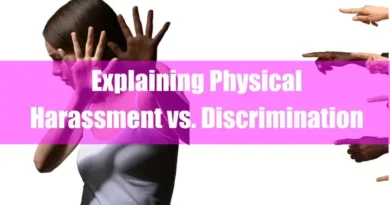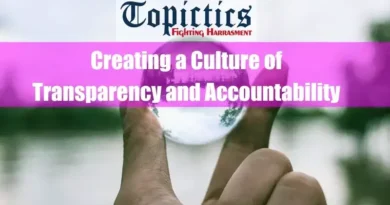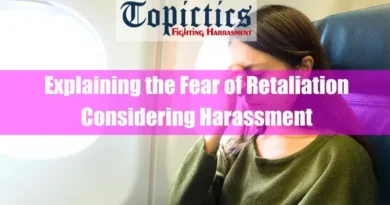Cultural Norms and Harassment: Understanding the Link
Takeaways
| Key Points |
|---|
| Cultural norms, while providing identity and cohesion, can also perpetuate harmful behaviors that enable harassment. |
| Misinterpreted traditions often legitimize harmful power dynamics, silence victims, or blur boundaries, as seen in gender roles, “joking” culture, and honor-based systems. |
| Cultural relativism may further complicate addressing harassment by excusing harmful practices under the guise of tradition. |
| However, cultural norms also hold the potential to foster change, with communal responsibility, rituals, and grassroots activism playing key roles in promoting equality and preventing harm. |
| By embracing dialogue, respecting diversity, and reinterpreting traditions, societies can transform cultural norms into forces that support respect, dignity, and safety for all. |
Let’s discuss in detail:
Introduction to Cultural Norms and Harassment
The insidious shadow of harassment stretches across cultures, encompassing unwanted behaviors from physical altercations to subtle psychological manipulation. Its legal and social definitions vary, encompassing quid pro quo threats, persistent verbal assaults, and even pervasive discrimination.
But to truly unpack its reach, we must delve deeper. Cultural norms, the bedrock of traditions and values, can both shield and perpetuate these harmful behaviors. Understanding this complex link between acceptance and abuse, between ingrained expectations and evolving rights, is crucial.
Only then can we wield cultural sensitivity and critical analysis to address harassment, dismantle its insidious hold, and build a world where everyone feels safe and respected.
Negative Aspects of the Link
While cultural traditions can offer richness and identity, they can also harbor blind spots that allow harmful behaviors to flourish. This section delves into the negative aspects of the link between cultural norms and harassment, highlighting the ways societal expectations and entrenched beliefs can legitimize, downplay, or even justify actions that cause significant harm.
A. Misinterpreted Traditions
- Gender Roles and Skewed Power Dynamics: Deep-seated gender norms that place certain groups at a disadvantage, particularly women and LGBTQ+ individuals, can create an environment where unwanted advances, discriminatory jokes, and even physical assault are seen as acceptable or inevitable. This fosters a culture of silence and inhibits victims from seeking help.
- “Joking” and the Mask of Harm: Practices of playful banter or teasing, although often rooted in cultural familiarity, can easily cross the line into harassment. Cultural acceptance of such behavior can make it difficult for individuals to identify and address harmful words or actions, blurring the boundaries between innocent fun and unacceptable abuse.
- Honor Cultures: Where Silence Reigns and Abuse Festers: In cultures where notions of honor are tightly bound to concepts of masculinity and family reputation, speaking out against abuse can be seen as an act of betraying the community or humiliating oneself. This creates a powerful incentive for silence, allowing abusive behavior to remain unchecked and victims to suffer in isolation.
B. Cultural Relativism

- The Quest for Universal Standards: Defining universally acceptable behavior across diverse cultural contexts is a complex and delicate task. Legal frameworks may struggle to effectively address culturally specific forms of harassment, leaving victims without adequate protection and perpetrators empowered by claims of cultural difference.
- Weaponizing Tradition: The “Normative Defense”: While valuable in respecting diversity, cultural relativism can be misused as a shield to excuse or justify harmful practices. Perpetrators may weaponize traditions or claim their actions are merely cultural norms, silencing criticism and perpetuating harmful behaviors.
- Bridging the Divide: Intercultural Dialogue for Change: Open and respectful dialogue between cultures is crucial in addressing the misuse of cultural relativism. By sharing perspectives and identifying shared values, communities can work together to challenge harmful traditions and advocate for cultural evolution that prioritizes respect and equality for all.
C. Examining the Lived Experience
- Workplace Crossroads: Culture Clashes in Harassment Reporting: Examining how cultural norms surrounding power dynamics, communication styles, and reporting mechanisms can influence how workplace harassment is reported, investigated, and resolved. Cultural sensitivity is crucial in ensuring fair and effective processes for all individuals, regardless of their background.
- FGM: Tradition’s Perilous Price: Exploring the complex interplay of tradition, religion, and social pressure in perpetuating Female Genital Mutilation, a harmful practice with severe physical and psychological consequences. Understanding the cultural factors at play is crucial in developing culturally sensitive and sustainable interventions to eradicate this practice.
- Cyberbullying’s Tangled Web: Where Culture Meets Digital Cruelty: Online harassment often takes on specific forms depending on cultural attitudes towards gender, appearance, and social status. Analyzing these cultural undercurrents is crucial in developing effective strategies to combat cyberbullying and promote a safer online environment for all.
By critically examining the negative aspects of the link between cultural norms and harassment, we can pave the way for a more nuanced and effective approach to addressing these harmful behaviors. Through open dialogue, cultural sensitivity, and a commitment to promoting equality for all, we can build a world where traditions evolve to become forces for good, empowering individuals and fostering a culture of respect and dignity.
Positive Aspects of the Link

While cultural norms can present challenges in addressing harassment, they also hold immense potential for positive change. This section explores how cultural values and traditions can be harnessed to foster supportive environments, empower individuals, and ultimately prevent harmful behaviors.
A. Cultivating Respect
- Elders as Guardians: Respect for elders is deeply ingrained in many cultures. This creates a safety net where individuals facing harassment can find support and guidance from respected community members. Traditional mechanisms for seeking advice and resolving disputes can offer alternative avenues for addressing grievances and preventing further harm.
- Communal Responsibility: Tight-knit communities often foster a sense of shared responsibility, where individuals are vested in each other’s well-being. This collective spirit can be a powerful deterrent against harassment, with community members intervening or speaking out against harmful behavior.
- Rituals and Celebrations: Cultural ceremonies and rituals can often act as repositories of values like respect, fairness, and empathy. When adapted and re-interpreted with a focus on inclusivity and equality, these traditions can serve as powerful tools for raising awareness, promoting positive social norms, and fostering a culture of non-tolerance towards harassment.
B. Challenging the Status Quo
- Voices on the Rise: Grassroots Activism: Within diverse cultures, individuals and communities actively campaign against harmful traditions and advocate for social change. From LGBTQ+ rights movements to campaigns against female genital mutilation, cultural activism is playing a crucial role in challenging discriminatory norms and empowering individuals to speak out against harassment.
- Rewriting the Narrative: Cultural values are not static; they evolve and adapt over time. This presents an opportunity to re-articulate and re-interpret cultural traditions in ways that promote equality and respect for all members of society. By drawing on positive existing values like resilience, collective responsibility, and compassion, new narratives that emphasize non-violence, mutual respect, and zero tolerance for harassment can be woven.
- Global Bridges: Cross-cultural dialogue and collaboration are key to developing effective strategies for preventing and addressing harassment. By sharing best practices, learning from each other’s experiences, and adapting successful interventions to different cultural contexts, communities can build bridges of understanding and support, forming a united front against harmful behaviors.
C. Stories of Hope and Transformation
- #MeToo’s Global Echo: While the #MeToo movement originated in the West, its powerful message of solidarity and resistance against sexual harassment resonated across diverse cultures. Local adaptations of the movement, considering specific cultural contexts and legal frameworks, have empowered women to speak out and demand change.
- Indigenous Pathways to Equality: Traditional ceremonies and rituals in many indigenous cultures promote values like respect, non-violence, and communal responsibility. These principles can be used to challenge harmful gender norms and empower women, creating safe spaces and fostering support systems for those who have experienced harassment.
- From Silence to Solidarity: Cultural understanding and collaboration have been instrumental in successful community-based initiatives against bullying and discrimination. By engaging local leaders, utilizing traditional communication channels, and tailoring interventions to specific cultural contexts, communities can create safer environments for all members.
By exploring the positive aspects of the link between cultural norms and preventing harassment, we can move beyond a simplistic “us vs. them” approach and embrace a cultural sensitivity and collaboration model. When traditions are harnessed for good, re-interpreted to reflect evolving values, and shared across cultures, they can become powerful tools for building a world where everyone feels safe, respected, and empowered to speak out against harmful behaviors.
Remember, cultural change is a journey, not a destination. By working together, building bridges, and amplifying voices, we can create a future where cultural norms become forces for good, promoting respect, equality, and a world free from harassment.
Solutions for the Negative Aspects

The intricate entanglement of cultural norms and harassment presents a labyrinthine challenge. While traditions offer rich tapestries of identity and belonging, they can also harbor blind spots that perpetuate harmful behaviors. To navigate this complex terrain, we must delve into solutions that address the negative aspects of this link, paving the way for a future where cultural values uphold respect and equality for all.
A. Deconstructing Misinterpretations
1. Challenging Gender Inequality:
Entrenched gender norms that disadvantage certain groups create fertile ground for harassment. Education and awareness campaigns dismantling these stereotypes are crucial. Empowering women and LGBTQ+ individuals through economic opportunities and leadership roles further fosters an environment where these voices are heard and respected.
2. Reframing “Joking” and “Teasing”:
Cultural practices of playful banter can easily mask harmful behavior. Open community discussions can redefine boundaries, ensuring humor remains lighthearted and inclusive. Bystander intervention training equips individuals to recognize and address microaggressions before they escalate.
3. Confronting Honor Cultures:
The silence often associated with “honor cultures” surrounding violence and abuse needs to be challenged. Safe spaces for reporting and support systems for victims are vital. Engaging community leaders and religious figures in dialogues about non-violence and respect can shift harmful narratives and encourage intervention.
B. Bridging the Relativism Gap
1. Developing Universal Benchmarks:
While acknowledging cultural diversity, establishing shared principles of respectful behavior sets a global baseline. International collaboration on legal frameworks and human rights standards fosters a common ground for addressing harassment across borders.
2. Combating Misuse of Cultural Relativism:
Weaponizing cultural traditions to excuse harmful behavior needs to be actively countered. Open communication and education highlight the distinction between legitimate cultural practices and those that violate basic human rights.
3. Fostering Intercultural Dialogue:
Cultivating respectful engagement between cultures is key to dismantling harmful norms. Cultural exchange programs, educational initiatives, and collaborative research projects build bridges of understanding and empathy, paving the way for collective action against harassment.
C. Transforming Realities
1. Workplace Culture Shifts:
Implementing anti-harassment policies tailored to diverse cultural perspectives within workplaces creates safe and inclusive environments. Training programs sensitize employees to cultural nuances and empower them to report and address instances of harassment effectively.
2. Eradicating FGM:
Tackling Female Genital Mutilation requires a multi-pronged approach. Engaging religious leaders to reframe interpretations of religious texts, providing alternative rites of passage for communities, and empowering women through education and economic opportunities are crucial steps toward ending this harmful practice.
3. Cyberbullying Solutions:
Cultural understanding is vital in crafting effective strategies against cyberbullying. Collaborating with social media platforms to develop culturally sensitive reporting mechanisms and promoting online etiquette campaigns tailored to specific cultural contexts can create safer digital spaces for all.
By implementing these solutions, we can begin to untie the knots of the labyrinth, transforming the negative aspects of the link between cultural norms and harassment into threads of positive change. Remember, this journey requires action, continuous learning, adaptation, and collaboration.
Through unwavering commitment and open dialogue, we can weave a future where all cultures celebrate respect, inclusivity, and a world free from harassment.
D. Moving Forward
Addressing the negative aspects of the link between cultural norms and harassment is not a solitary endeavor. It demands a collective tapestry woven from the threads of:
- Continued Research and Scholarship: A deeper understanding of the nuanced interplay between cultures and harassment through ongoing research and academic discourse is crucial for informing effective interventions.
- Empowering Vulnerable Communities: Providing resources, support systems, and legal aid to individuals and groups particularly vulnerable to harassment empowers them to speak out and seek redress.
- Culturally Sensitive Policymaking: Developing legal frameworks and policies that consider and respect cultural contexts while upholding universal human rights principles ensures effective implementation and promotes justice for all.
By embracing these action threads, we can create a vibrant tapestry of change. As we move forward, let us remember that cultural norms are not static; they evolve and adapt over time. By nurturing positive values within these traditions and fostering a spirit of open dialogue and collaboration, we can transform the negative aspects of this link into forces for good, weaving a future where cultural diversity flourishes alongside an unwavering commitment to respect and equality for all.
Together, we can unravel the complexities of this labyrinth and build a world where the rich tapestry of cultures shines brightly, untarnished by the darkness of harassment.
Conclusion
Unraveling the intricate link between cultural norms and harassment reveals both darkness and light. While traditions can harbor harmful blind spots, their inherent values also hold immense potential for positive change. Addressing harassment demands an effective, nuanced approach that acknowledges this complexity.
Navigating this delicate terrain requires understanding cultural contexts, fostering cross-cultural dialogue, and empowering vulnerable individuals. Through ongoing research, open communication, and collaborative efforts, we can dismantle harmful norms and reimagine traditions as forces for good.
Let us embark on this journey not with blame but with understanding, weaving a future where cultural diversity flourishes free from the shadows of harassment.
FAQ
What is Cultural Relativism in Harassment?
Cultural relativism in harassment refers to the idea that behaviors considered inappropriate or harassing in one culture may be acceptable or tolerated in another due to differing societal norms and values. This concept challenges the universal application of harassment definitions, as some cultures may normalize behaviors such as persistent advances, gendered jokes, or workplace power imbalances that others see as unacceptable. Cultural relativism can create ethical dilemmas in multinational workplaces, requiring organizations to establish clear policies that respect global standards while acknowledging local customs.
What is Gendered Microaggression?
Gendered microaggressions are subtle, often unintentional discriminatory remarks, behaviors, or attitudes that reinforce gender stereotypes and contribute to a hostile environment. These can include comments that diminish a person’s expertise based on gender, assumptions about career priorities (e.g., assuming a woman prioritizes family over work), or patronizing language. While seemingly minor, repeated microaggressions create cumulative stress and can deter individuals from career advancement or participation in certain spaces.
What is Hostile Benevolence?
Hostile benevolence describes situations where seemingly protective or well-intentioned behaviors reinforce harmful power dynamics and gender roles, often limiting the autonomy of the targeted individual. For example, in workplaces, male supervisors may exclude female employees from challenging assignments to shield them from stress. While appearing supportive, this behavior ultimately restricts career growth and perpetuates gender inequities in professional development.
What is Normalization of Harassment?
Normalization of harassment refers to the process by which repeated exposure to inappropriate behavior leads to its acceptance within a society, workplace, or community. This can happen through cultural narratives that downplay harassment (e.g., “boys will be boys”), lack of enforcement of policies, or social pressure discouraging victims from speaking out. When harassment becomes normalized, it reduces accountability, silences victims, and perpetuates a culture of tolerance toward misconduct.
What is Workplace Gaslighting?
Workplace gaslighting occurs when perpetrators of harassment manipulate victims into doubting their perceptions of inappropriate behavior, making them question their experiences or memories. This tactic often silences complaints, maintains control, or protects perpetrators from consequences. It can involve dismissing concerns as overreactions, altering records to contradict a victim’s account, or persuading bystanders to support a false narrative. Gaslighting erodes confidence and contributes to psychological distress among victims.
What is Power Distance in Harassment?
Power distance refers to the extent to which lower-status individuals in a society or organization accept and expect power imbalances. In high power-distance cultures, subordinates may feel reluctant to challenge authority figures, even in harassment cases. This dynamic discourages reporting and enables abuse of power, as victims fear retaliation or social ostracization. Addressing harassment in such environments requires clear protections for whistleblowers and cultural shifts promoting open communication.
What is Victim-Blaming Culture?
A victim-blaming culture is a societal norm that shifts responsibility for harassment from the perpetrator to the victim, often questioning their behavior, clothing, or decisions. This mentality discourages reporting, reinforces stigma, and allows harassment to persist unchallenged. It is frequently reinforced by media portrayals, judicial biases, and social expectations that prioritize an individual’s perceived actions over addressing the actual misconduct of the harasser.
What is Silent Complicity?
Silent complicity occurs when individuals or organizations passively allow harassment to continue by failing to intervene, report, or support victims. This inaction can stem from fear of retaliation, cultural conditioning, or bystander apathy. Silence reinforces harmful behaviors, emboldening perpetrators while making victims feel isolated. Addressing silent complicity requires active bystander intervention, clear reporting mechanisms, and leadership commitment to anti-harassment policies.
What is the Tolerance Threshold in Harassment?
The tolerance threshold refers to the level of inappropriate behavior a society, organization, or individual is willing to accept before taking action. Some cultures have higher thresholds, dismissing casual sexism or inappropriate jokes as harmless, while others adopt zero-tolerance policies. High tolerance thresholds enable environments where minor infractions escalate into more severe harassment, making proactive cultural change essential in addressing the issue.
What is Institutional Betrayal in Harassment Cases?
Institutional betrayal occurs when an organization, school, or workplace fails to protect individuals from harassment or retaliate against those who report misconduct. This can involve covering up allegations, prioritizing the institution’s reputation over victims’ well-being, or creating barriers to reporting. Institutional betrayal erodes trust and discourages individuals from seeking justice, making systemic reforms and accountability essential for addressing workplace harassment.
What is the Retaliation Cycle in Harassment Cases?
The retaliation cycle refers to the systematic backlash victims or whistleblowers face after reporting harassment. This can include demotion, termination, social exclusion, or damage to professional reputation. Fear of retaliation often deters individuals from coming forward, allowing harassment to persist unchecked. Legal protections and strong anti-retaliation policies are crucial to breaking this cycle and ensuring victims feel safe reporting misconduct.
What is the Cultural Justification of Harassment?
Cultural justification of harassment occurs when societies rationalize inappropriate behavior based on traditional beliefs, religious interpretations, or historical gender roles. For example, some cultures may condone workplace harassment under the guise of “harmless flirtation” or discourage women from reporting abuse to protect family honor. Such justifications hinder progress toward gender equity and require cultural awareness training to challenge ingrained biases.
What is the Glass Precipice Effect in Harassment?
The glass precipice effect refers to situations where marginalized individuals, especially women or minorities, are placed in high-risk leadership roles where they face a higher likelihood of failure, often due to workplace harassment, exclusion, or lack of support. This phenomenon reinforces workplace inequities by setting individuals up for failure and then using their struggles to justify continued exclusion from leadership roles.
What is Selective Accountability in Harassment Cases?
Selective accountability refers to the practice of enforcing harassment policies inconsistently, often based on the perpetrator’s status, social connections, or perceived value to an organization. High-profile individuals, executives, or influential figures may receive leniency, while lower-status employees face severe consequences. This double standard erodes trust in harassment policies and highlights the need for equal enforcement regardless of rank or influence.
What is the Culture of Silence in Harassment?
A culture of silence refers to an environment where individuals, workplaces, or entire communities are discouraged from having open discussions about harassment. Fear of ostracization, legal repercussions, or workplace retaliation often makes victims and bystanders remain silent. This perpetuates harassment and allows perpetrators to act with impunity. Breaking this culture requires systemic change, including clear protections for whistleblowers, survivor-centered policies, and leadership-driven transparency initiatives.









